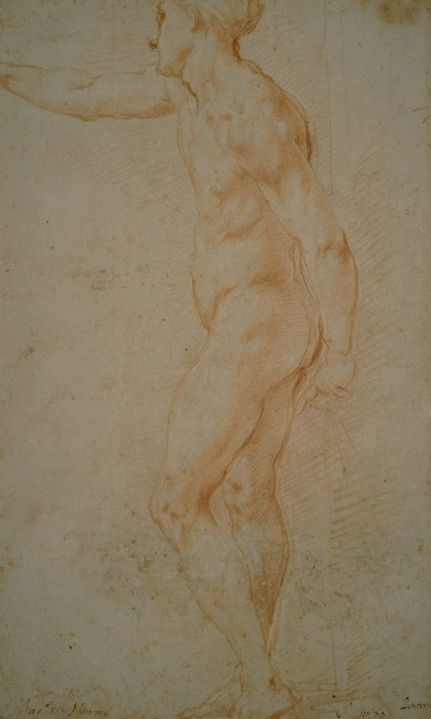Jacopo Carrucci was known as Pontormo after his place of birth, Pontorme, near Empoli, where he was born in 1494.
Together with Rosso Fiorentino, he was one of the main exponents of the Mannerist style.
From his very first works, which include the "Sacred Conversation" (1514) and the "Visitation" (1516) at the Santissima Annunziata Church in Florence, he differed from the dreamy, graceful style of his master, Andrea del Sarto, showing a very spiritual and restless temperament in his anxious, unsettled style.
As a young man he also painted the "Flight of Joseph" (1515-19), at London's National Gallery, the "Pucci Altar-piece" for the Church of San Michele Visdomini, and the "Portrait of Cosimo the Elder" (1518-19), in the Tribune at the Uffizi, in which the subject is dressed in magnificent red brocade, but has a sad, thoughtful gaze (in the same room is the emotionally strong "Virgin and Child with St. Giovannino").
His "Scenes from the life of St. Joseph" (1515-19) at the National Gallery in London, are noteworthy for their quality of highly meditative characterization, which shows the influence of Albert D'uumlrer, also seen in Pontormo's later works.
Important under this aspect are the "Adoration of the Magi" (1523), at the Pitti Palace; "Vertunno and Pomona" (1521), at the Medicea Villa of Poggio a Caiano; the "Scenes of the Passion" (1523-25), at the Charterhouse of Galluzzo and the "Supper at Emmaus" (1525), at the Uffizi (in the room dedicated to Pontormo himself and Rosso Fiorentino, which also houses the "Portrait of a musician", "St. Anthony Abbot", the "Portrait of Maria Salviati" and the "Birth of St. John" tondo, in which the tall, thin figures fit in perfectly with the composition).
In his last paintings, the "Visitation" (1528-30) at St. Michael's Parish Church in Carmignano, and the "Deposition" (1526-28) at the Santa Felicita' Church in Florence, the bodies, wrapped in brightly coloured clothes appear heavier and more "earthly", despite the insense mysticism in their expressions.
The artist died in 1556.
Jacopo Carrucci plus connu comme Pontormo d'après son lieu de naissance, Pontorme, près d'Empoli, où il est né dans 1494.
Avec Rosso Fiorentino, il était un des principaux acteurs du style Manièriste.
De ses toutes premières œuvres, qui incluent "la Conversation Sacrée" (1514) et "la Visitation" (1516) dans l'église de la Sainte Annonciation à Florence, il a différé du style rêveur et gracieux de son maître, Andrea del Sarto, montrant un tempérament très spirituel et agité dans un style inquiet et instable.
Tout jeune homme il a aussi peint "le Vol de Joseph" (1515-19), à la Galerie nationale de Londres; le "Retable Pucci" pour l'Église de Saint Michele Visdomini San et "le Portrait de Cosimo l'Aîné" (1518-19), dans la Tribune à l'Uffizi, dans lequel Cosimo est paré d'un magnifique brocart rouge, mais a un regard fixe triste, pensif (dans la même salle on trouve le portrait émotionnellement fort de "la Vierge et l'Enfant avec Saint Giovannino").
Son tableau : "Scènes de la vie de Saint Joseph" (1515-19) à la Galerie nationale à Londres, est remarquable pour la qualité de caractérisation fortement méditative, qui montre l'influence d'Albert D'uumlrer, aussi vu dans les œuvres postérieures de Pontormo.
Important sous cet aspect sont "l'Adoration de Rois mages" (1523), au Palais Pitti; "Vertunno et Pomona" (1521), à la Villa Medicis de Poggio a Caiano; "les Scènes de la Passion" (1523-25), au Charterhouse de Galluzzo et "le Dîner à Emmaus" (1525), à l'Uffizi (dans la salle consacrée à Pontormo lui-même et Rosso Fiorentino, qui abrite aussi "le Portrait d'un musicien", "St. Anthony Abbot", le "Portrait de Maria Salviati" et la "Naissance de St John" tondo, dans lequel les figures, grandes, minces, s'adaptent parfaitement avec la composition).
Dans ses dernières peintures, "la Visitation" (1528-30) à l'Église paroissiale de St Michel de Carmignano et "la Déposition" (1526-28) à l'église Sainte Félicité de Florence, les corps, enveloppés dans des vêtements vivement colorés apparaissent plus lourds et "plus terrestres", malgré le mysticisme intense de leurs expressions.
L'artiste est mort dans 1556.
